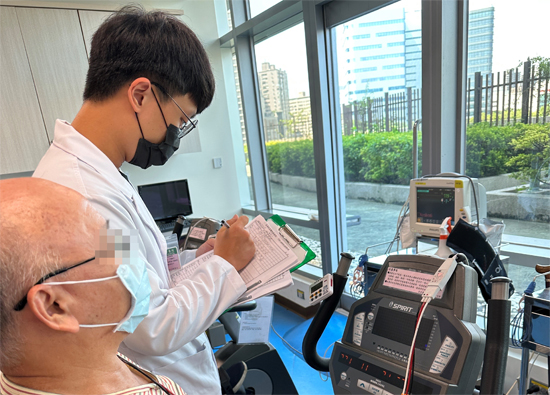10.2023 Life Guide
Don't underestimate the silent disease 'osteoporosis'
Dr. Chen Yuhong, Department of Orthopedics, Far Eastern Memorial Hospital /


 Osteoporosis is the second most prevalent disease worldwide, second only to cardiovascular disease. Due to the imperceptible symptoms of the disease, also known as a hidden killer, the public should prevent it early and supplement calcium appropriately. If diagnosed with osteoporosis by a doctor, early treatment is also necessary to ensure treatment effectiveness.
Osteoporosis is the second most prevalent disease worldwide, second only to cardiovascular disease. Due to the imperceptible symptoms of the disease, also known as a hidden killer, the public should prevent it early and supplement calcium appropriately. If diagnosed with osteoporosis by a doctor, early treatment is also necessary to ensure treatment effectiveness.What is osteoporosis
There are osteoblasts and osteoclasts in the bone, which act daily to achieve bone remodeling and metabolism. However, since the age of 35, as adults age, their osteogenic ability decreases and their bone erosion ability relatively increases, resulting in an annual bone loss of about 0.5-1%; Starting from the age of 50, the rate of loss is faster, about 1-3% per year. Due to bone loss, bone pores become larger and more loose, causing bones to be fragile and prone to fracture, increasing the risk of fractures.
Osteoporosis and fractures
Taiwan is already an aging society and is moving towards a "super elderly society", and one of the two major epidemics in this society is osteoporosis. The National Nutrition Survey report points out that the prevalence rates of osteoporosis in men and women over the age of 50 are 23.9% and 38.3%, respectively. The impact on patients and society is the terrifying consequences of various fractures, among which hip, vertebral, and wrist fractures are the most common. Especially, the first two types of fractures increase the risk of death.
Taiwan belongs to a high-risk area for fractures, with one-third of women over 50 years old and one-fifth of men experiencing one hip, vertebral, or wrist fracture in their lifetime. Taking hip fractures as an example, the average annual increase in cases over the age of 50 is 9.3%, especially for patients with osteoporosis. Once a hip fracture occurs, the one-year mortality rate is 11.2% for women and 18% for men, which is much higher than the standard mortality rate (only 2.8% for women and 3.6% for men).
In addition, the prevalence of vertebral fractures in Taiwan over the age of 65 in 1994 was 19.5% for females and 12% for males. Even if a vertebral fracture may not necessarily result in fracture, compression and deformation of the vertebral body may cause symptoms such as hunchback, height reduction, and back pain, requiring X-ray examination of the vertebral body. Once confirmed as a vertebral fracture, vertebroplasty or corrective surgery must be performed. If left untreated, it will seriously affect the lung and digestive system, and increase the probability of further fractures.
Bone density testing
The dual energy X-ray absorptiometry (DXA) is a bone density testing method recognized by the World Health Organization for the diagnosis of osteoporosis. When used, the patient's "lumbar spine" and "hip bone" should be measured simultaneously. If both cannot be measured correctly, it can be replaced by a measurement at one-third of the radius of the non habitual forearm, and the T-value (bone density detection value - average bone density value of young Caucasian women)/standard deviation) can be converted based on the test results, Determine the degree of osteoporosis. If it is greater than -1, it indicates that the bone is normal- 1-2.5 indicates that bone loss has begun, and can usually be strengthened by supplementing nutrition and adjusting lifestyle habits; If it is less than -2.5, it indicates severe bone loss, and the subject has already developed osteoporosis, which may require medication to control the condition.
How to prevent osteoporosis?
Osteoporosis is caused by long-term bone loss, and usually does not have obvious symptoms in the early stages of the disease, so it is easily overlooked. However, it is still possible to protect bones and slow down the rate of bone loss by supplementing calcium and vitamin D, exercising enough, avoiding smoking and alcohol, and preventing falls.
Common osteoporosis medication treatment
1. Increase osteogenesis
Therapeutic drugs include parathyroid hormone, which is artificially synthesized to increase the activity of osteoblasts, promote bone hyperplasia, and increase bone density, but also accelerate bone loss. Patients need to receive subcutaneous injections once a day, with side effects including nausea, dizziness, etc.
2. Reduce bone erosion
This is currently a common treatment method that can slow down the rate of bone loss. Therapeutic drugs include:
Diphosphate drugs: They can inhibit the activity of bone etching cells and reduce the bone etching effect, but the drugs are easily accumulated in the body and can take months to years to eliminate, and can easily cause gastrointestinal discomfort.
Selective estrogen receptor modulators: have the effect of inhibiting bone erosion and must be taken daily; Common adverse reactions include leg edema, cramps, and venous embolism.
RANKL inhibitors and osteoprotegerins: can reduce the effect of osteoclasts and require subcutaneous injection every six months. Due to the low injection frequency, patients have a high acceptance rate; Side effects may result in adverse reactions to skin allergies.
3. Reduce bone erosion+increase osteogenesis
Inhibitors of sclerotin: A new choice for drug therapy, which can achieve a dual effect of reducing bone erosion and increasing osteogenesis. As long as the concentration of anti sclerotin in the body is reduced, it can increase bone density in multiple ways and delay bone loss. Patients only need to receive subcutaneous injections once a month for a year to complete treatment, and then continue to use anti loss drugs.
Prevention is better than treatment
Osteoporosis causes fractures, which will burden individuals, families, and society with medical care. It is recommended to learn more about this disease, undergo bone density testing, and avoid falls. With the concept of "prevention is better than treatment", we can work together to prevent fractures.
Dr. Chen Yuhong's expertise includes fracture trauma, minimally invasive surgery for fractures, general orthopedic diseases, degenerative arthritis, sciatica, low back and lower back pain, osteoporosis, bone tumors/soft tissue tumor diseases, skeletal muscle system ultrasound, etc.
#




















